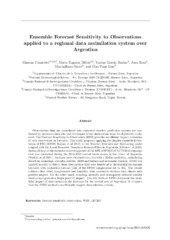Mostrar el registro sencillo del ítem
Ensemble Forecast Sensitivity to Observations applied to a regional data assimilation system over Argentina
| dc.contributor.author | Casaretto, Gimena | |
| dc.contributor.author | Dillon, María Eugenia | |
| dc.contributor.author | García Skabar, Yanina | |
| dc.contributor.author | Ruiz, Juan José | |
| dc.contributor.author | Sacco, Maximiliano | |
| dc.contributor.author | Lien, Guo-Yuan | |
| dc.date.accessioned | 2021-12-22T12:55:00Z | |
| dc.date.available | 2021-12-22T12:55:00Z | |
| dc.date.issued | 2021 | |
| dc.identifier.uri | http://hdl.handle.net/20.500.12160/1752 | |
| dc.description | Fil: Dillon, María Eugenia. Servicio Meteorológico Nacional. Dirección Nacional de Ciencia e Innovación en Productos y Servicios. Dirección de Productos de Modelación Ambiental y de Sensores Remotos; Argentina. Consejo Nacional de Investigaciones Científicas y Técnicas. Universidad de Buenos Aires. Facultad de Ciencias Exactas y Naturales. Departamento de Ciencias de la Atmósfera y los Océanos; Argentina. | es |
| dc.description.abstract | Observations that are assimilated into numerical weather prediction systems are con- formed by numerous data sets and the impact of the observations must be objectively evalu- ated. The Forecast Sensitivity to Observation (FSO) provides an e cient impact evaluation of each observation on forecasts. This study proposes applying the simpler ensemble formu- lation of FSO (EFSO, Kalnay et al 2012) to the Weather Research and Forecasting model coupled with the Local Ensemble Transform Kalman Filter in Argentina (Dillon et al 2019), during 25 days of the intensive observing period of the RELAMPAGO-CACTI eld campaign that was conducted during the 2018-2019 austral warm season in the center of Argentina (Nesbitt et al 2021). Analyses were obtained every 6-h with a 20-km resolution, assimilating data from soundings, aircrafts, satelite, AIRS and surface and automatic stations. EFSO was applied in order to detect those observations that were bene cial or detrimental for regional forecasts with evaluation forecast time of the EFSO computation set to 6-h. The results evidence that wind, temperature and humidity from automatic stations have almost nule positive impact. On the other hand, sounding, aircrafts and atmospheric infrared sounder observations present a larger positive impact. Also the elds of EFSO document the bene- cial impact of observations in the forecasts for the central area of Argentina. It is shown that the EFSO method can e ciently suggest data selection criteria. | es |
| dc.format | application/pdf | |
| dc.language.iso | spa | es |
| dc.publisher | Science Conf | es |
| dc.rights | info:eu-repo/semantics/openAccess | es |
| dc.subject | FORECAST SENSITIVITY | es |
| dc.subject | OBSERVATION | es |
| dc.subject | WRF | es |
| dc.subject | LETKF | es |
| dc.title | Ensemble Forecast Sensitivity to Observations applied to a regional data assimilation system over Argentina | es |
| dc.type | artículo | es |
| dc.rights.license | http://creativecommons.org/licenses/by/2.5/ar/ | es |
Ficheros en el ítem
Este ítem aparece en la(s) siguiente(s) colección(ones)
-
Resúmenes [113]
